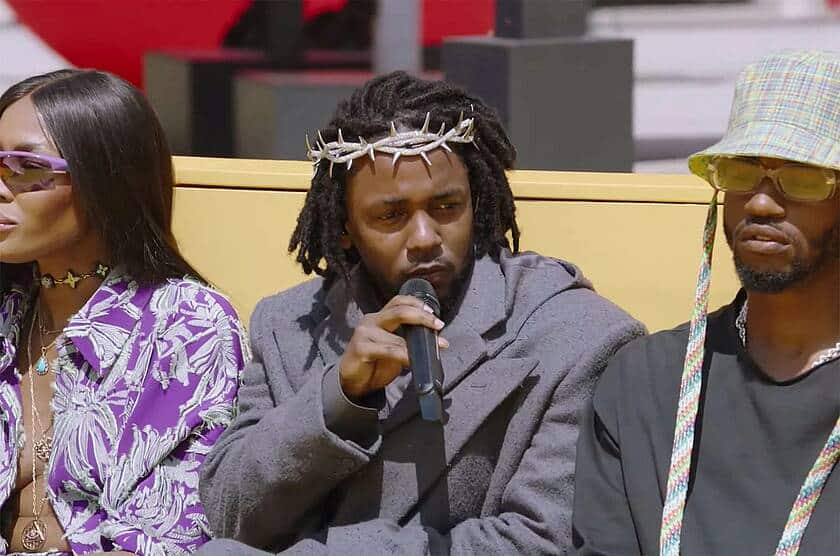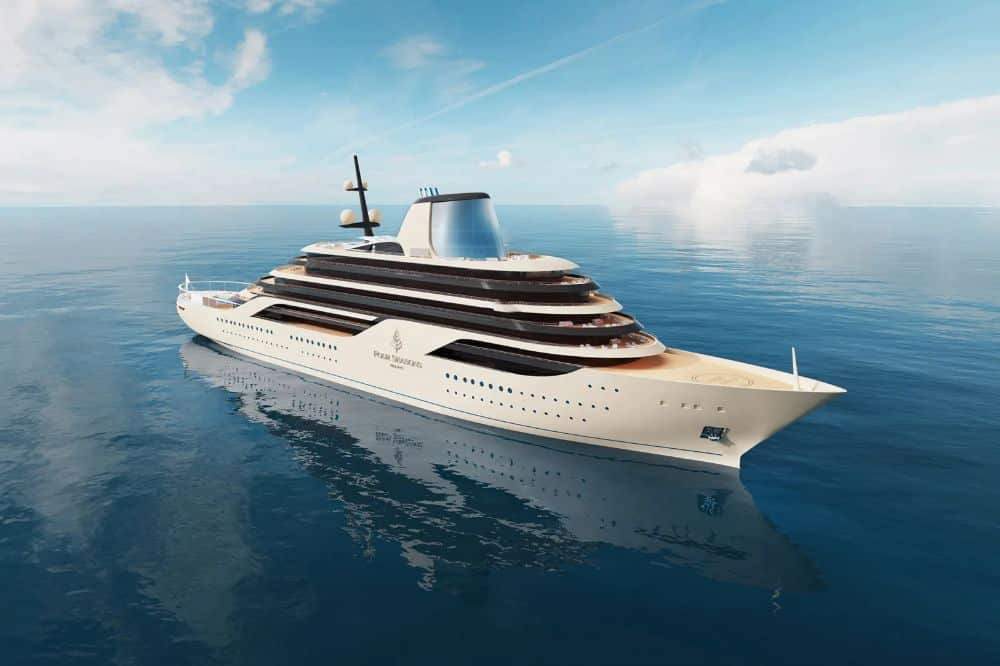[vc_row njt-role=”people-in-the-roles” njt-role-user-roles=”administrator,editor,author,armember”][vc_column][vc_column_text]
Rappers and other hip-hop artists have often been rejected by luxury brands, but today, it is rather the opposite that we observe. What’s the value of this reversal?
Crowned with a diamond-set thorn halo by Tiffany & Co and draped in Louis Vuitton, Kendrick Lamar, one of the hottest musicians of his generation, was front row at Louis Vuitton‘s Spring/Summer 2023 men’s fashion show in June. And this alongside the iconic supermodel Naomi Campbell. During the show, he didn’t just watch: he also performed 4 songs from his latest album. The show then ended with a touching vocal and visual tribute to Virgil Abloh, culminating in a symbolic event: it was held at the Cour Carré of the Louvre Museum, precisely where Virgil Abloh had organized his very first show as artistic director for the French fashion house.
The scene was a telling demonstration of the modern alliance between the luxury industry and hip-hop. For those who witnessed the birth of this musical movement nearly 50 years ago, amidst the total indifference of the luxury world, the adoption of this black art form by such a prestigious House was almost surreal. Yet it has not been a smooth ride: this happy marriage was initially one of appropriation and cross-fertilization.
“When you think about the relationship between hip-hop, rap music and fashion houses today, it’s unimaginable,” comments June Ambrose, Jay-Z and Missy Elliott‘s former stylist, now creative director at Puma. “Cardi B wears Schiaparelli, Chanel and Balmain couture. At the time, we couldn’t even get them on the phone.”
Birth of hip-hop
The emergence of hip-hop in the 1970s and early 1980s was a far cry from the Parisian ateliers and elegant parties of haute couture. Instead, it coincided with the onset of the crack epidemic in the American inner cities. From New York to Los Angeles, the drug was turning black men into junkies and…millionaires.
“This is reality,” explains Bronx-born designer and stylist K. Tyson Perez, who recently launched a social media campaign accusing Givenchy of appropriating his designs. “It starts with the retailers. Hip-hop culture and rappers have been influenced by the street – by drug dealers.” Gold chains, four-finger rings, diamond-set watches and Cuban link chains were the pieces of choice then. Eighties bands like Run-DMC, Kurtis Blow, LL Cool J and others performed in their sporty outfits, adorned with flashy jewelry. And urban, hip-hop-loving youth quickly followed suit. This generation grew up in affluent white neighborhoods, as evidenced by popular 1980s television shows such as Dynasty, which witnessed the growing popularity of European fashion houses such as Armani and Versace.
The year 1988 marked the launch of YO MTV Raps, which televised the hip-hop revolution. Hip-hop was no longer secretly listened to to beat the blues in the inner city, but was now played everywhere and embraced by all social classes. As Hip-Hop became more mainstream in the 1990s, rappers’ flair for jewelry and fashion became increasingly recognized. New leaders emerged, such as Biggie Smalls, whose penchant for rhyming about luxury brands, from cars to clothes, marked a whole generation.
Artist Lil’ Kim, who didn’t just quote brands in her lyrics, also used them for every photo shoot and video, thanks to her stylist at the time, Misa Hylton. Now one of the most iconic images in hip-hop and fashion, Lil’ Kim showed her love for Louis Vuitton by posing with the LV logo painted all over her body for photographer David LaChapelle in 1999.

Despite the initial obstacles, designers have created iconic and luxurious looks for Hip Hop artists, forcing fashion houses to take notice, especially with a new development: urban fashion brands. Although Hip Hop culture has embraced mainstream European and American brands, it is now ready to assert its own fashion identity.
Hip-hop takes on luxury
“Hip-hop has kind of taken over entertainment on many levels and has become very mainstream,” says Mickey Boardman, former editorial director of Paper magazine. “And you see white kids singing hip-hop, talking about hip-hop, dressing hip-hop even though they’re from the suburbs or wherever.”
As images of white teenagers wearing velour tracksuits and baggy jeans proliferated, the luxury industry began to question. Chanel was one of the first to jump in. For the fall of 1991, Karl Lagerfeld, then creative director, introduced what became known as “the hip-hop collection,” featuring quilted baseball caps and copious amounts of solid gold and denim.
More recently, the rise of social media has given black culture a welcome channel of communication and contributed to the growth of independent black brands with luxury appeal, including Public School, Telfar, Pyer Moss and Virgil Abloh’s Off-White. The latter has actually figured out how to turn hoodies, sneakers and other high-street goods into coveted luxury items. “Virgil Abloh wasn’t the first to merge luxury and streetwear, but he did it brilliantly and made it a mainstream approach to modern luxury for a younger clientele, which will influence luxury and high-end design in the 2020s,” explains Roger Tredre, instructor in fashion communication at Central Saint Martins in London.

Emil Wilbekin looks forward to “seeing how this idea [of luxury and hip-hop] has manifested itself, and seeing black people like Virgil Abloh, Pharrell Williams, Swizz Beats, Jay-Z and Beyoncé, living this life of wealth, abundance and power through a black prism, and forcing luxury to reimagine itself because of the blackness and reality that we have brought.”
Today, hip-hop artists are treated like VIPs at fashion houses: they are guaranteed front row access, appearances in ad campaigns, and makeovers with luxury items on loan from the houses. Artists have proven to be the gateway to a multi-billion dollar industry that spans generations and social classes. Rapper and music executive Rick Ross is philosophical about the slow adoption of luxury: “Luxury brands haven’t always been so welcoming, so that’s good,” he tells Robb Report. “You know, we come from the mud, we come from the bottom, so luxury has always been one of our many goals.”
Lire aussi > [Luxus+ Magazine] Back to childhood for the Louis Vuitton spring-summer 2023 men’s show
Photo à la Une : © Louis Vuitton[/vc_column_text][/vc_column][/vc_row][vc_row njt-role=”not-logged-in”][vc_column][vc_column_text]
Rappers and other hip-hop artists have often been rejected by luxury brands, but today, it is rather the opposite that we observe. What’s the value of this reversal?
Crowned with a diamond-set thorn halo by Tiffany & Co and draped in Louis Vuitton, Kendrick Lamar, one of the hottest musicians of his generation, was front row at Louis Vuitton‘s Spring/Summer 2023 men’s fashion show in June. And this alongside the iconic supermodel Naomi Campbell. During the show, he didn’t just watch: he also performed 4 songs from his latest album. The show then ended with a touching vocal and visual tribute to Virgil Abloh, culminating in a symbolic event: it was held at the Cour Carré of the Louvre Museum, precisely where Virgil Abloh had organized his very first show as artistic director for the French fashion house.
The scene was a telling demonstration of the modern alliance between the luxury industry and hip-hop. For those who witnessed the birth of this musical movement nearly 50 years ago, amidst the total indifference of the luxury world, the adoption of this black art form by such a prestigious House was almost surreal. Yet it has not been a smooth ride: this happy marriage was initially one of appropriation and cross-fertilization.
[…][/vc_column_text][vc_cta h2=”This article is reserved for subscribers.” h2_font_container=”tag:h2|font_size:16|text_align:left” h2_use_theme_fonts=”yes” h4=”Subscribe now !” h4_font_container=”tag:h2|font_size:32|text_align:left|line_height:bas” h4_use_theme_fonts=”yes” txt_align=”center” color=”black” add_button=”right” btn_title=”I SUBSCRIBE !” btn_color=”danger” btn_size=”lg” btn_align=”center” use_custom_fonts_h2=”true” use_custom_fonts_h4=”true” btn_button_block=”true” btn_custom_onclick=”true” btn_link=”url:https%3A%2F%2Ftest2023.luxus-plus.com%2Fen%2Fsubscriptions-and-newsletter-special-offer-valid-until-september-30-2020-2-2%2F”]Get unlimited access to all articles and live a new reading experience, preview contents, exclusive newsletters…
Already have an account ? Please log in.
[/vc_cta][vc_column_text]Featured photo : © Louis Vuitton[/vc_column_text][/vc_column][/vc_row][vc_row njt-role=”people-in-the-roles” njt-role-user-roles=”subscriber,customer”][vc_column][vc_column_text]
Rappers and other hip-hop artists have often been rejected by luxury brands, but today, it is rather the opposite that we observe. What’s the value of this reversal?
Crowned with a diamond-set thorn halo by Tiffany & Co and draped in Louis Vuitton, Kendrick Lamar, one of the hottest musicians of his generation, was front row at Louis Vuitton‘s Spring/Summer 2023 men’s fashion show in June. And this alongside the iconic supermodel Naomi Campbell. During the show, he didn’t just watch: he also performed 4 songs from his latest album. The show then ended with a touching vocal and visual tribute to Virgil Abloh, culminating in a symbolic event: it was held at the Cour Carré of the Louvre Museum, precisely where Virgil Abloh had organized his very first show as artistic director for the French fashion house.
The scene was a telling demonstration of the modern alliance between the luxury industry and hip-hop. For those who witnessed the birth of this musical movement nearly 50 years ago, amidst the total indifference of the luxury world, the adoption of this black art form by such a prestigious House was almost surreal. Yet it has not been a smooth ride: this happy marriage was initially one of appropriation and cross-fertilization.
[…][/vc_column_text][vc_cta h2=”This article is reserved for subscribers.” h2_font_container=”tag:h2|font_size:16|text_align:left” h2_use_theme_fonts=”yes” h4=”Subscribe now !” h4_font_container=”tag:h2|font_size:32|text_align:left|line_height:bas” h4_use_theme_fonts=”yes” txt_align=”center” color=”black” add_button=”right” btn_title=”I SUBSCRIBE !” btn_color=”danger” btn_size=”lg” btn_align=”center” use_custom_fonts_h2=”true” use_custom_fonts_h4=”true” btn_button_block=”true” btn_custom_onclick=”true” btn_link=”url:https%3A%2F%2Ftest2023.luxus-plus.com%2Fen%2Fsubscriptions-and-newsletter-special-offer-valid-until-september-30-2020-2-2%2F”]Get unlimited access to all articles and live a new reading experience, preview contents, exclusive newsletters…
Already have an account ? Please log in.
[/vc_cta][vc_column_text]Featured photo : © Louis Vuitton[/vc_column_text][/vc_column][/vc_row][vc_row njt-role=”people-in-the-roles” njt-role-user-roles=”subscriber,customer”][vc_column][vc_column_text]









